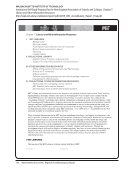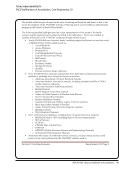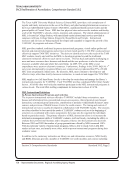86 · Representative Documents: Programmatic Accrediting Agency Reports
Johns Hopkins University
Accreditation Board of Engineering Technology. Sheridan Libraries 2011 ABET Report
Overview
The Sheridan Libraries have a history of strong and continued support of the engineering programs at
Johns Hopkins University. Significant resources are allocated to build collections and services that
support the research and teaching of the faculty and students. One floor of the library building is
dedicated to Engineering and Science and houses a dedicated reference area, the offices of the
engineering and science librarians, current periodicals, computers, and study space. The library is aware
that, in terms of student enrollment, 3 of the top 10 undergraduate and 4 of the top 10 graduate
programs at JHU are in the School of Engineering. The library serves the Engineering School with core
services for collection development and liaison services which includes instruction and reference.
Liaison Services
The School of Engineering is served by three liaison librarians who provide instruction, research, and
collection development support to the faculty, graduate students, and undergraduates. This combined
approach to service allows the librarians to develop a deep understanding of the research and teaching
needs of the faculty in various engineering programs at JHU. In addition, it gives faculty the benefit of
one contact point for all things library. This also allows for the librarian to be deeply embedded in the
department so they can better understand user needs and anticipate changes in library collections and
instruction to support changing research agendas.
Discipline-specific instruction in research methods takes the form of individual and small group research
consultations course-related, classroom-based library instruction orientation to the library’s services,
collections, and principal resources in engineering and development of curricular materials to assist
faculty and students in navigating and evaluating information sources and content. During FY 10, the
liaisons taught a total of 57 engineering- and science-related classes and reached over 1,000 students.
Because our engineering programs are highly interdisciplinary, the liaisons also cover basic sciences such
as mathematics, life sciences, and physical sciences that fulfill core requirements in engineering. They
also work with business and economics librarians to serve those programs that include business
development and technology transfer. Because engineering is practiced across the Hopkins campuses,
the engineering librarians work with colleagues on the Hopkins medical campus and Applied Physics
Laboratory to support cross-campus research programs and initiatives.
The library has developed a guide that serves as a launching point for engineering research:
http://guides.library.jhu.edu/engineering. It is routinely one of the top 10 most frequently consulted
guides, with over 11,000 page hits in 2010.
Budget
The library fully understands the resources needs of the engineering programs and funds those needs
accordingly. Of the total library materials budget of $11.5M in FY11, 45.2 percent goes toward
engineering and science resources. Over the past five years, the library has been moving aggressively
from print to electronic resources 85 percent of the funds allocated to engineering are dedicated to
electronic resources. Given the highly interdisciplinary nature of engineering and its dependency on
core science and mathematics as foundations, the budget is allocated for science and engineering as a
whole, with the librarians balancing the specific needs of all of their departments within a very large
$5.4M annual budget allocation. Approximately 69 percent of that budget is allocated for
serials/journals. The library has a unique model for funding electronic resources as we work closely with
the Medical School and Applied Physics Laboratory to extend our buying power by avoiding duplication
and negotiating for resources as one institution.
Johns Hopkins University
Accreditation Board of Engineering Technology. Sheridan Libraries 2011 ABET Report
Overview
The Sheridan Libraries have a history of strong and continued support of the engineering programs at
Johns Hopkins University. Significant resources are allocated to build collections and services that
support the research and teaching of the faculty and students. One floor of the library building is
dedicated to Engineering and Science and houses a dedicated reference area, the offices of the
engineering and science librarians, current periodicals, computers, and study space. The library is aware
that, in terms of student enrollment, 3 of the top 10 undergraduate and 4 of the top 10 graduate
programs at JHU are in the School of Engineering. The library serves the Engineering School with core
services for collection development and liaison services which includes instruction and reference.
Liaison Services
The School of Engineering is served by three liaison librarians who provide instruction, research, and
collection development support to the faculty, graduate students, and undergraduates. This combined
approach to service allows the librarians to develop a deep understanding of the research and teaching
needs of the faculty in various engineering programs at JHU. In addition, it gives faculty the benefit of
one contact point for all things library. This also allows for the librarian to be deeply embedded in the
department so they can better understand user needs and anticipate changes in library collections and
instruction to support changing research agendas.
Discipline-specific instruction in research methods takes the form of individual and small group research
consultations course-related, classroom-based library instruction orientation to the library’s services,
collections, and principal resources in engineering and development of curricular materials to assist
faculty and students in navigating and evaluating information sources and content. During FY 10, the
liaisons taught a total of 57 engineering- and science-related classes and reached over 1,000 students.
Because our engineering programs are highly interdisciplinary, the liaisons also cover basic sciences such
as mathematics, life sciences, and physical sciences that fulfill core requirements in engineering. They
also work with business and economics librarians to serve those programs that include business
development and technology transfer. Because engineering is practiced across the Hopkins campuses,
the engineering librarians work with colleagues on the Hopkins medical campus and Applied Physics
Laboratory to support cross-campus research programs and initiatives.
The library has developed a guide that serves as a launching point for engineering research:
http://guides.library.jhu.edu/engineering. It is routinely one of the top 10 most frequently consulted
guides, with over 11,000 page hits in 2010.
Budget
The library fully understands the resources needs of the engineering programs and funds those needs
accordingly. Of the total library materials budget of $11.5M in FY11, 45.2 percent goes toward
engineering and science resources. Over the past five years, the library has been moving aggressively
from print to electronic resources 85 percent of the funds allocated to engineering are dedicated to
electronic resources. Given the highly interdisciplinary nature of engineering and its dependency on
core science and mathematics as foundations, the budget is allocated for science and engineering as a
whole, with the librarians balancing the specific needs of all of their departments within a very large
$5.4M annual budget allocation. Approximately 69 percent of that budget is allocated for
serials/journals. The library has a unique model for funding electronic resources as we work closely with
the Medical School and Applied Physics Laboratory to extend our buying power by avoiding duplication
and negotiating for resources as one institution.
























































































































































































